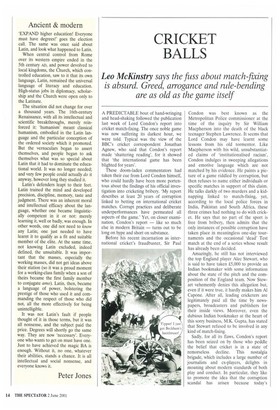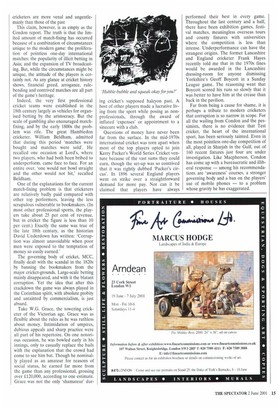CRICKET BALLS
Leo McKinstry says the fuss about match-fixing
is absurd. Greed, arrogance and rule-bending are as old as the game itself
A PREDICTABLE bout of hand-wringing and head-shaking followed the publication last week of Lord Condon's report into cricket match-fixing. The once noble game was now suffering its darkest hour, we were told. Typical was the view of the BBC's cricket correspondent Jonathan Agnew, who said that Condon's report made 'shattering reading', for it showed that 'the international game has been blighted for years'.
These doom-laden commentators had taken their cue from Lord Condon himself, who could hardly have been more portentous about the findings of his official investigation into cricketing bribery. 'My report describes at least 20 years of corruption linked to betting on international cricket matches. Corrupt practices and deliberate underperformances have permeated all aspects of the game.' Yet, on closer examination, Condon's report — like so much else in modern Britain — turns out to be long on hype and short on substance.
Before his recent incarnation as international cricket's fraudbuster, Sir Paul Condon was best known as the Metropolitan Police commissioner at the time of the inquiry by Sir William Macpherson into the death of the black teenager Stephen Lawrence. It seems that Lord Condon may have learnt some lessons from his old tormentor. Like Macpherson with his wild, unsubstantiated claims of 'institutionalised racism', Condon indulges in sweeping allegations and emotive language which are not matched by his evidence. He paints a picture of a game riddled by corruption, but then refuses to name either individuals or specific matches in support of this claim. He talks darkly of two murders and a kidnapping linked to match-fixing, yet, according to the local police forces in India, Pakistan and South Africa, these three crimes had nothing to do with cricket. He says that no part of the sport is free from bribery, then admits that the only instances of possible corruption have taken place in meaningless one-day tournaments and the occasional 'dead' Test match at the end of a series whose result has already been decided.
Amazingly, he still has not interviewed the top England player Alec Stewart, who is said to have taken £5,000 to provide an Indian bookmaker with some information about the state of the pitch and the composition of the England team. Now Stewart vehemently denies this allegation but, even if it were true, it hardly makes him Al Capone. After all, leading cricketers are legitimately paid all the time by newspapers, broadcasters and publishers for their inside views. Moreover, even the dubious Indian bookmaker at the heart of this sorry business, M.K. Gupta, has stated that Stewart refused to be involved in any kind of match-fixing.
Sadly, for all its flaws, Condon's report has been seized on by those who peddle the belief that cricket is in a state of remorseless decline. This nostalgia brigade, which includes a large number of journalists and ex-players, delights in moaning about modern standards of both play and conduct. In particular, they like to promote the idea that the corruption scandal has arisen because today's cricketers are more venal and ungentlemanly than those of the past This claim, however, is as empty as the Condon report. The truth is that the limited amount of match-fixing has occurred because of a combination of circumstances unique to the modern game: the proliferation of pointless one-day international matches; the popularity of illicit betting in Asia; and the expansion of TV broadcasting. But, while the circumstances might be unique, the attitude of the players is certainly not. As any glance at cricket history shows, financial greed, arrogance, rulebending and contrived matches are all part of the game's heritage.
Indeed, the very first professional cricket teams were established in the 18th century largely as vehicles for organised betting by the aristocracy. But the scale of gambling also encouraged matchfixing, and by the early 1800s the prob lem was rife. The great Hambledon cricketer, William Beldham, admitted that during this period 'matches were bought and matches were sold'. He recalled one occasion at Lord's, where two players, who had both been bribed to underperform, came face to face. For an entire over, 'one would not bowl straight and the other would not hit,' recalled Beldham.
One of the explanations for the current match-fixing problem is that cricketers are relatively badly paid compared with other top performers, leaving the less scrupulous vulnerable to bookmakers. (In most other professional sports, the play ers take about 25 per cent of revenue, but in cricket the figure is less than 10 per cent.) Exactly the same was true of the late 18th century, as the historian David Underdown has written: 'Corrup tion was almost unavoidable when poor men were exposed to the temptation of money so easily earned.'
The governing body of cricket, MCC, finally dealt with the scandal in the 1820s by banning the bookmakers from the major cricket-grounds. Large-scale betting mainly disappeared, and with it the blatant corruption. Yet the idea that after this crackdown the game was always played in the Corinthian spirit, with absolute probity and untainted by commercialism, is just absurd.
Take W.G. Grace, the towering cricketer of the Victorian age. Grace was as flexible about the rules as he was ruthless about money. Intimidation of umpires, dubious appeals and sharp practice were all part of his repertoire. On one notori ous occasion, he was bowled early in his innings, only to casually replace the bails with the explanation that the crowd had come to see him bat. Though he nominally played as an amateur for reasons of social status, he earned far more from the game than any professional, grossing over £120,000, according to one estimate. Grace was not the only `shamateue dur ing cricket's supposed halcyon past. A host of other players made a lucrative living from the sport while posing as nonprofessionals, through the award of inflated 'expenses' or appointment to a sinecure with a club.
Questions of money have never been far from the surface. In the mid-1970s international cricket was torn apart when most of the top players opted to join Kerry Packer's World Series Cricket venture because of the vast sums they could earn, though the set-up was so contrived that it was rightly dubbed 'Packer's circus'. In 1896 several England players went on strike over a straightforward demand for more pay. Nor can it be claimed that players have always
performed their best in every game. Throughout the last century and a half, there have been exhibition games, festival matches, meaningless overseas tours and county fixtures with universities where the competition is less than intense. Underperformance can have the strangest origins. The former Lancashire and England cricketer Frank Hayes recently told me that in the 1970s fines would be awarded in the Lancashire dressing-room for anyone dismissing Yorkshire's Geoff Boycott in a Sunday League game. The reasoning went that Boycott scored his runs so slowly that it was better to have him at the crease than back in the pavilion.
Far from being a cause for shame, it is perhaps a tribute to modern cricketers that corruption is so narrow in scope. For all the wailing from Condon and the pessimists, there is no evidence that Test cricket, the heart of the international sport, has been seriously tainted. Even in the most pointless one-day competition of all, played in Sharjah in the Gulf, out of 160 recent fixtures just four are under investigation. Like Macpherson, Condon has come up with a bureaucratic and illiberal response — among his recommendations are 'awareness' courses, a stronger governing body and a ban on the players' use of mobile phones — to a problem whose gravity he has exaggerated.











































































 Previous page
Previous page